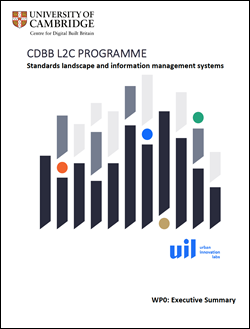
Submitted by Angela Walters on Fri, 22/06/2018 - 10:17
Dr Andrew Robinson is a co-founder and partner of Urban Innovation Labs, the organisation commissioned by the Centre for Digital Built Britain (CDBB) to report on the Level 2 Convergence (L2C) programme. In this blog Andy explains the importance of L2C in leveraging the full value of a digital built Britain.
The recently published CDBB L2C Programme: Standards landscape and information management systems report tests whether the existing standards and data structures enable the direct relationship to be established between the beneficiaries of services provided by assets, the end-user, and the planning, design and maintenance of the assets. Essentially looking down the telescope from the other end from the perspective of the end-user and the outcomes they receive, rather than the traditional feed-forward approach from planning, design, build and maintain. The purpose of exploring this relationship is to leverage socio-economic outcomes from the assets constructed – a key component of the CDBB mission to digitally transform the full lifecycle of the built environment to increase productivity and improve economic and social outcomes in the UK and beyond.
 The focus for the L2C report emerged from research work completed last year by Urban Innovation Labs looking at the development of the Operate and Integrate programme strategy for the Centre for Digital Built Britain. It became clear there is a big step – and a technology implementation gap – between Design and Build (L2 - the improved asset delivery and maintenance) and Operate and Integrate (the smart operation and performance of a portfolio of assets), which is the gateway to the optimisation of organisational business services and socio-economic outcomes.
The focus for the L2C report emerged from research work completed last year by Urban Innovation Labs looking at the development of the Operate and Integrate programme strategy for the Centre for Digital Built Britain. It became clear there is a big step – and a technology implementation gap – between Design and Build (L2 - the improved asset delivery and maintenance) and Operate and Integrate (the smart operation and performance of a portfolio of assets), which is the gateway to the optimisation of organisational business services and socio-economic outcomes.
This integrated and interoperable phase brings together the client groups (cities, asset owners and operators), the technology cohorts and the construction and asset management sector and requires these large sectors of the economy to work closely together, which presents a major challenge.
One of the objectives of the L2C report was to begin to address this challenge. We started by considering the critical information that links all of these different groups. This required identifying which standards (de jure or de facto) define the information and interfaces, then comparing how the information is structured using a range of data models shared with different exchange models.
Standards and information management systems became the main theme of the report which set out the current standards landscape in relation to the CDBB mission, with particular focus on how information is used and exchanged between all of these different audiences, and what information is critical to enable us to link the outcomes and benefits that we are seeking back to the asset and built environment. This is important in order to better understand the contribution of the built environment towards the overall productivity of the services delivered.
The current standards landscape relating to all of the sectors and industries within the remit of the CDBB programme is vast. The L2C programme considers whether the existing range of de jure or de facto standards enable the establishment of the whole asset lifecycle end-to-end relationship. It also applies a methodology to create meta-standards, which are a standard of standards from a particular perspective and may be the breakthrough in establishing the connections and common language across a number of different standards in different disciplines, from different perspectives and at different stages of the asset lifecycle.
In some sectors there is a direct and closely coupled relationship between a service and its infrastructure, as in the case of transport. In other sectors, such as healthcare, there are other factors that are often dominant. The L2C report proposes a pilot project that would help us to really understand and measure how an asset makes a significant contribution to the socio-economic outcomes of services; we propose that services will be delivered more efficiently and effectively if the built environment is better planned, designed, maintained and operated.
L2C and the role that standards play is fundamental to the future of our built environment and socio-economic outcomes. The built environment is the engine room of our cities and society. It is essential that we find ways to plan, design, build, manage and operate our infrastructure more efficiently because of the challenges we face as a society and as a planet. We need to find ways to make our built environment more effective in delivering what we need from it. The UK has the opportunity to lead the way in this field, to secure solutions that support the digitally-enabled transformation of the full lifecycle of the built environment that will bring benefits to all.
• CDBB L2C Programme: Standards landscape and information management systems
• Dr Andrew Robinson is a co-founder and partner of Urban Innovation Labs (web update due end June 2018). Urban Innovation Labs would like to thank partners BSI and PCSG for supporting the delivery of this project.
